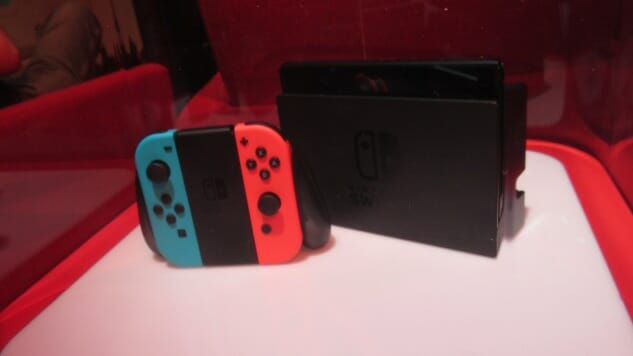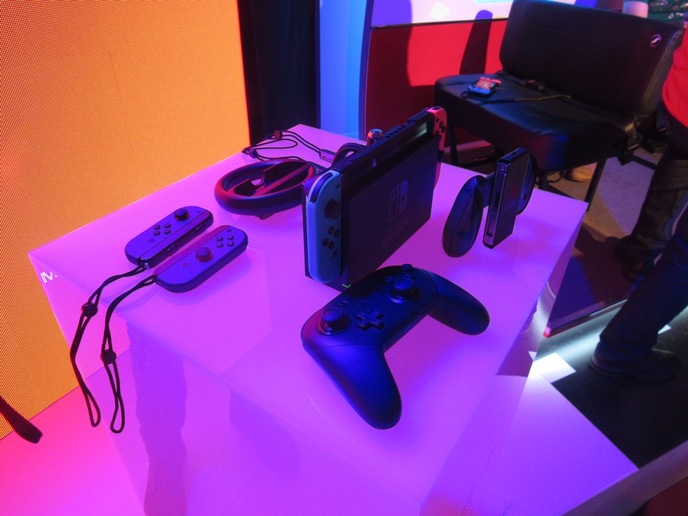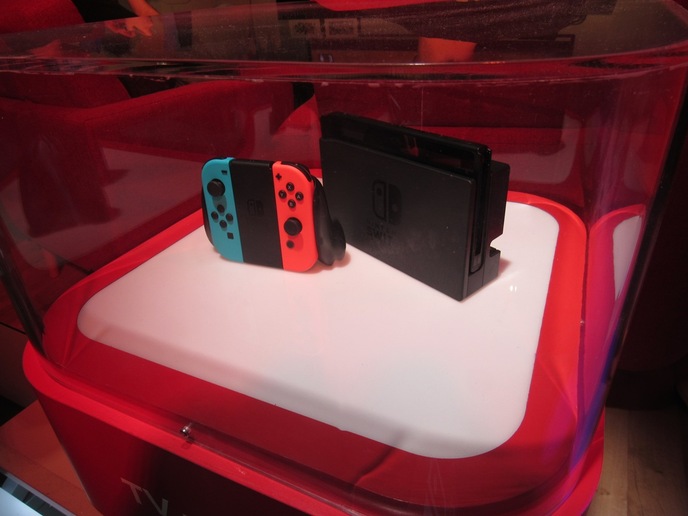The Nintendo Switch: Untangling The Mysteries of Nintendo’s Newest Console
Photos by Garrett Martin Games Features Nintendo Switch
Until the last several weeks, little was definitively known about Nintendo’s next console. Like so much of game development, the whole project was shrouded in mystery for most of its life. A new system was known to be in the works since early 2015, barely two years after the Wii U’s release, and Nintendo dribbled out small bits of info about the then-named NX over the next several months, but it wasn’t until last November that they revealed its current name and confirmed its hybrid console-portable nature. Even then, few details were released about the Nintendo Switch until late last week, when Nintendo held a livestream from Tokyo on Thursday to announce concrete specifics about the hardware and its games. Afterward, the company held press events around the world, where journalists had their first opportunity to see and play the system. I was at the event in New York, and was able to play a variety of games that showed off the multiple ways to interact with the Switch. Although much of the mystery is now gone, a lot of questions remain. Let’s try to answer some of them, starting with the hardware itself and the weirdly conceived new controllers that Nintendo has called Joy-Cons. I’ll discuss the games I played in New York in a separate post soon.
The Nintendo Switch can be hard to understand if you haven’t actually played it. On the surface Nintendo’s new console seems to embrace the two defining features of its two direct predecessors: like the Wii U, it’s partially a tablet, and like the Wii, its main controllers are motion-sensing wands. Nintendo takes a very different approach to both of these facets, though, prioritizing one far more than it has in the past, while effectively sidelining the other as an optional feature for select games.
Let’s start with the latter. Yes, the Joy-Con controllers can function like miniature Wii Remotes when held individually. In some games they will act like the Wii Remote and nunchuk tandem, with a player holding one Joy-Con in each hand to play the game. In other games two players can hold one Joy-Con each and compete with or against each other. The Joy-Cons are more versatile than the Wii Remotes, with an analogue joystick and more buttons on each controller than the Remote. That makes them more useful as an old-school NES-style game pad, which some games will use them as. They also snap into place on the Switch tablet, giving you the feel and ease of mobile gaming but with traditional videogame controls. And when you’re playing at home, the Joy-Cons can snap into the Joy-Con Grip controller shell to become a de facto traditional gaming controller. They can function as motion controllers, but the vast majority of games at the Switch press event didn’t involve any motion sensing at all, largely defaulting to the fully assembled Joy-Con Grip configuration. Basically, if you don’t like motion controls, don’t worry—that hardly seems like a priority for the Switch.
As for the tablet aspect, the Switch goes much deeper in that direction than the Wii U ever did, and in fact accomplishes what many assumed the Wii U would do. The Switch is a true tablet that you can take on the go with you. It runs the exact same games that you play on your TV screen because the tablet itself is the console when it’s docked and plugged into your TV. When I was playing The Legend of Zelda: Breath of the Wild, I seamlessly transitioned from TV to tablet, snapping the Joy-Cons out of the Grip, pulling the Switch out of the dock, and sliding the Joy-Cons into position on either side of the tablet. With the Joy-Cons in place, it was heavier than an iPad, and might be hard to play on a really crowded subway train, but it wasn’t awkward or uncomfortable to hold it, and the game looked almost as beautiful on the handheld’s HD screen as it did on the TV. If you’re a Nintendo fan who got tired of explaining to friends and family how the Wii U tablet wasn’t actually portable, and didn’t work more than a few feet away from the base unit, you’ll be happy to know the Switch is fully portable. Of course it has a short battery life (between two and five hours, depending on the game), which will limit its usefulness as a mobile device, and the dual-screen interactions of the Wii U and DS won’t be possible, but the Switch will finally make good on what many assumed was the implicit promise of the Wii U when its Gamepad was first revealed.
Being able to play Switch games on the go is a big feature, but it’s the versatility of the Joy-Cons that made the biggest impression on me during last week’s press event. I played various games with multiple implementations of the Joy-Con, and other than a short adjustment period where I had to get used to their small size and the awkwardness of the Grip, I had no problems with the devices. It was easy to slide them onto the tablet or into the Grip, and just as easy to remove them again. The motion controls were more precise than I expected. In the boxing game Arms, the Joy-Cons could read when I threw a hook, and my boxer’s reach clearly expanded the further I stuck out my own arm. For 1, 2 Switch, a minigame compilation that takes a note from Johann Sebastian Joust and wants players to look at each other instead of the television, the Joy-Cons registered when my rival and I drew and fired them like six-shooters, and how quickly and smoothly we pumped the controllers up and down while alternating buttons in a cow-milking game. It felt far more precise and less obtrusive than the Wii Motion Plus, and makes me think motion controls still have a future in videogames.
The most striking thing about the Joy-Cons, though, is something that few games will probably ever utilize. If you watched the Switch livestream from Tokyo late Thursday night, you heard a Nintendo spokesman talk about something called HD Rumble. It’s a silly name for a neat piece of technology that can simulate heft and motion within the Joy-Con. In 1, 2 Switch it’s used for a minigame where you have to guess how many marbles are inside the controller. As you tilt the controller back and forth you can feel and hear objects sliding around inside. The more you angle it, the faster the fake marbles roll around, and the louder they get when they crash into each other. It’s a wonderful trick, and shows how much more advanced the Joy-Con is from the Wii Remote or other older motion controllers, but it’s also hard to see how often something like this can be incorporated into a videogame.
After getting my hands on the Switch, and trying out its tablet mode and its unusual new controllers, I think the potential is there for this to be something special. There are a lot of hurdles Nintendo will have to clear for this to be a success, from the price point, to confusion over the product, to competition from phones and tablets, to the further decay of their traditional gaming audience. If the company can cultivate mainstream awareness of what the Switch is and can do, it could tap into the same market that the Wii did ten years ago. The success of Super Mario Run and Pokemon Go (which, yes, they are only minority partners in) proves that Nintendo’s games and properties still resonate powerfully with players. Whether Nintendo’s hardware can still seize the zeitgeist in that way, after the failure of the Wii U and the Wii’s soft final years, is the biggest mystery of all about the Switch.
We’ll have more from the Nintendo Switch press event soon.
Garrett Martin edits Paste’s games, comedy and wrestling sections. He’s on Twitter @grmartin.


